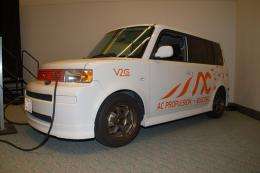US project seeks to make the family car a cash cow

US researchers unveiled a vehicle Thursday that earns money for its driver instead of guzzling it up in gasoline and maintenance costs.
The converted Toyota Scion xB, shown at the annual meeting of the American Association for the Advancement of Science here, is the first electric car to be linked to a power grid and serve as a cash cow.
"This is the first vehicle that's ever been paid to participate in the grid -- the first proof of concept vehicle," Ken Huber, who oversees technological development at wholesale electricity coordinator PJM Interconnection, told AFP.
The presentation of the box-like, unassuming looking Scion was the researchers' way of introducing the "vehicle-to-grid" (V2G) concept as it begins to gain momentum in the United States and around the world.
V2G projects with hybrid cars that use electricity and gas to store energy in their batteries and feed it back into the power grid are up and running in the United States, and the drive now is to produce all electric vehicles to plug into the power grid.
"This makes the car useful not only when it's being driven, but also when it's parked, as long as you remember to plug it in," said Willett Kempton, who is leading a V2G project at the University of Delaware.
A V2G car is connected via an Internet-over-powerline connection that sends a signal from inside the car's computer to an aggregator's server.
The aggregator acts as the middleman between the car owner and power grid management companies, which are constantly trying to keep electricity output at a constant level.
When the grid needs more power due to a surge in demand, power companies usually draw from traditional power plants, which in the United States are often coal-fired and leave a large carbon footprint.
When V2G becomes more widespread, the power could be drawn from millions of vehicles plugged into sockets in home garages or from commercial fleets, such as the US Postal Service's vans, for a much smaller footprint than that of the power plants.
Grid management companies like PJM Interconnection currently pay around 30 dollars an hour when taking power from a car.
V2G is still a new concept, but it is gaining ground in the United States and Europe.
"Ten years ago, this was just a plan. Today, it's a real project and in 10 years, we'll be producing tens of megawatts of power this way," said Kempton, adding that V2G will readily find applications in countries that are rapidly ramping up reliance on wind and solar energy, such as Denmark and Britain.
Huber said he will be meeting in the coming weeks in Paris with heads of European grid management companies about V2G.
"We're going to try to determine how we can work together on this. It's a technology that is very good at meeting a need we have, and there's growing interest among auto companies to develop V2G vehicles," he added.
AC Propulsion of California has designed an electric drive system for V2G, and car manufacturers including Renault/Nissan, Mitsubishi and BMW are producing all-electric vehicles with an eye on the V2G market.
(c) 2010 AFP



















